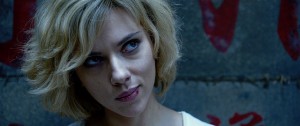Interview: Michel Gondry of “Mood Indigo”
Posted on August 2, 2014 at 3:50 pm
Michel Gondry is one of my favorite directors, with a distinctive style of romance and whimsy, best known for “Eternal Sunshine of the Spotless Mind” and “Be Kind Rewind.” His films usually feature intricate contraptions with a very hand-made feeling. His latest film, starring “Amelie’s” Audrey Tautou, is based on a popular French novel first published in 1947 novel by Boris Vian with a title usually translated as “Froth on the Daydream”. Gondry is the perfect choice for a film that features a “pianoktail,” a piano that makes cocktails according to which tune is played on its keys, and a character who becomes ill because a water lily is growing in her lung. The book has been filmed twice before and turned into an opera, but in Gondry it has found the perfect person to translate its bittersweet allegory to cinema.
I spoke to Gondry about why handmade items still matter and which item from the film he would like to have in real life.
In a world of CGI effects that feel realer than reality, it is very endearing to see a film that is filled with charming items that all feel very handmade.
I am surrounded by function, and I am not very good at decorating or being organized. It is very messy most of the time. But I like to make things and to have people make things for my movies. It is very nice when you can see the construction and the results, when you can take it in your hand and it moves and functions, where you can see the mechanics and the guts inside. You want things to be made my people, not things made by things. You don’t want robots to be designing the items you are going to buy like it’s a sign of better quality. I don’t see it that way. A lot of the films I saw when I was growing up, you could tell how things were made and I found that exciting. It stimulates the creativity of the viewer. You would be inspired and want do make the things yourself. If you show how it is made, people will think about how to make it themselves. It’s a democratization of creativity.
The actors have to believe that they are in a real world. The fact that everything was made, there was no green screen, helped them. They have to jump into this world so they can feel the emotion they would feel in the real world.
If you could have one of the movie’s contraptions in real life, what would it be?
I have the airplane. I like some of the cars we did. One was made by two very famous French cars from the 60’s and 70’s. Storing items costs more money than building them. It’s too bad.
The book that inspired the movie is still very beloved in France, isn’t it?
Yes, I was about 15 when I first read it. Everyone has their own take on it. That puts some pressure on me to not fail them — some people say, “Don’t make this book into a film because we love it!” That scared me a little. But I have to forget about that and the best I could.
The movie’s US title comes from an American song and American jazz plays a role in the film.
Duke Ellington is very important to the story. The character Chloe has a name inspired by a Duke Ellington song. And I grew up listening to Duke Ellington. Two heroes in the house — Duke Ellington and Serge Gainsbourg
, who was in a way sort of a student of Ellington. So I did put a lot of Ellington music in the movie and it was very important to honor that spirit.
What did you tell your actors about maintaining a reality in a partially fairy tale setting?
They asked me a lot of questions about who their characters were and where they came from. I don’t like to intellectualize the background of each character. It should come from themselves. They just have to be themselves and believe in the moment. I don’t think they need to create a heavy psychology. The psychology of the emotion comes from the situation and what is going on. They don’t have to imagine a full and complex story for each character.
Am I right in seeing some influence by George Méliès in your work?
Yes. He was a magician first and used the camera to complexify his tricks. And he discovered most of the effects that were used in cinema until CGI. He had the ingenuity and creativity and complete freedom in his work that I really got inspired by.


